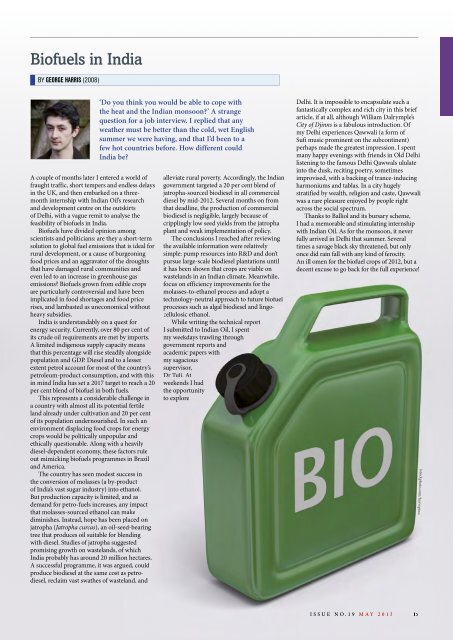Issue 19, 2013 - Balliol College - University of Oxford
Issue 19, 2013 - Balliol College - University of Oxford
Issue 19, 2013 - Balliol College - University of Oxford
You also want an ePaper? Increase the reach of your titles
YUMPU automatically turns print PDFs into web optimized ePapers that Google loves.
Bi<strong>of</strong>uels in India<br />
By george hArris (2008)<br />
A couple <strong>of</strong> months later i entered a world <strong>of</strong><br />
fraught traffic, short tempers and endless delays<br />
in the uK, and then embarked on a threemonth<br />
internship with indian oil’s research<br />
and development centre on the outskirts<br />
<strong>of</strong> Delhi, with a vague remit to analyse the<br />
feasibility <strong>of</strong> bi<strong>of</strong>uels in india.<br />
Bi<strong>of</strong>uels have divided opinion among<br />
scientists and politicians: are they a short- term<br />
solution to global fuel emissions that is ideal for<br />
rural development, or a cause <strong>of</strong> burgeoning<br />
food prices and an aggravator <strong>of</strong> the droughts<br />
that have damaged rural communities and<br />
even led to an increase in greenhouse gas<br />
emissions Bi<strong>of</strong>uels grown from edible crops<br />
are particularly controversial and have been<br />
implicated in food shortages and food price<br />
rises, and lambasted as uneconomical without<br />
heavy subsidies.<br />
india is understandably on a quest for<br />
energy security. Currently, over 80 per cent <strong>of</strong><br />
its crude oil requirements are met by imports.<br />
A limited indigenous supply capacity means<br />
that this percentage will rise steadily alongside<br />
population and GDP. Diesel and to a lesser<br />
extent petrol account for most <strong>of</strong> the country’s<br />
petroleum-product consumption, and with this<br />
in mind india has set a 2017 target to reach a 20<br />
per cent blend <strong>of</strong> bi<strong>of</strong>uel in both fuels.<br />
this represents a considerable challenge in<br />
a country with almost all its potential fertile<br />
land already under cultivation and 20 per cent<br />
<strong>of</strong> its population undernourished. in such an<br />
environment displacing food crops for energy<br />
crops would be politically unpopular and<br />
ethically questionable. Along with a heavily<br />
diesel-dependent economy, these factors rule<br />
out mimicking bi<strong>of</strong>uels programmes in Brazil<br />
and America.<br />
the country has seen modest success in<br />
the conversion <strong>of</strong> molasses (a by-product<br />
<strong>of</strong> india’s vast sugar industry) into ethanol.<br />
But production capacity is limited, and as<br />
demand for petro-fuels increases, any impact<br />
that molasses-sourced ethanol can make<br />
diminishes. instead, hope has been placed on<br />
jatropha (Jatropha curcas), an oil-seed-bearing<br />
tree that produces oil suitable for blending<br />
with diesel. studies <strong>of</strong> jatropha suggested<br />
promising growth on wastelands, <strong>of</strong> which<br />
india probably has around 20 million hectares.<br />
A successful programme, it was argued, could<br />
produce biodiesel at the same cost as petrodiesel,<br />
reclaim vast swathes <strong>of</strong> wasteland, and<br />
‘Do you think you would be able to cope with<br />
the heat and the Indian monsoon’ A strange<br />
question for a job interview. I replied that any<br />
weather must be better than the cold, wet English<br />
summer we were having, and that I’d been to a<br />
few hot countries before. How different could<br />
India be<br />
alleviate rural poverty. Accordingly, the indian<br />
government targeted a 20 per cent blend <strong>of</strong><br />
jatropha-sourced biodiesel in all commercial<br />
diesel by mid-2012. several months on from<br />
that deadline, the production <strong>of</strong> commercial<br />
biodiesel is negligible, largely because <strong>of</strong><br />
cripplingly low seed yields from the jatropha<br />
plant and weak implementation <strong>of</strong> policy.<br />
the conclusions i reached after reviewing<br />
the available information were relatively<br />
simple: pump resources into R&D and don’t<br />
pursue large- scale biodiesel plantations until<br />
it has been shown that crops are viable on<br />
wastelands in an indian climate. Meanwhile,<br />
focus on efficiency improvements for the<br />
molasses-to-ethanol process and adopt a<br />
technology-neutral approach to future bi<strong>of</strong>uel<br />
processes such as algal biodiesel and lingocellulosic<br />
ethanol.<br />
While writing the technical report<br />
i submitted to indian oil, i spent<br />
my weekdays trawling through<br />
government reports and<br />
academic papers with<br />
my sagacious<br />
supervisor,<br />
Dr tuli. At<br />
weekends i had<br />
the opportunity<br />
to explore<br />
Delhi. it is impossible to encapsulate such a<br />
fantastically complex and rich city in this brief<br />
article, if at all, although William Dalrymple’s<br />
City <strong>of</strong> Djinns is a fabulous introduction. <strong>of</strong><br />
my Delhi experiences Qawwali (a form <strong>of</strong><br />
sufi music prominent on the subcontinent)<br />
perhaps made the greatest impression. i spent<br />
many happy evenings with friends in old Delhi<br />
listening to the famous Delhi Qawwals ululate<br />
into the dusk, reciting poetry, sometimes<br />
improvised, with a backing <strong>of</strong> trance-inducing<br />
harmoniums and tablas. in a city hugely<br />
stratified by wealth, religion and caste, Qawwali<br />
was a rare pleasure enjoyed by people right<br />
across the social spectrum.<br />
thanks to <strong>Balliol</strong> and its bursary scheme,<br />
i had a memorable and stimulating internship<br />
with indian oil. As for the monsoon, it never<br />
fully arrived in Delhi that summer. several<br />
times a savage black sky threatened, but only<br />
once did rain fall with any kind <strong>of</strong> ferocity.<br />
An ill omen for the bi<strong>of</strong>uel crops <strong>of</strong> 2012, but a<br />
decent excuse to go back for the full experience!<br />
istockphoto.com/harvepino<br />
issue no.<strong>19</strong> MAY <strong>2013</strong><br />
15
















